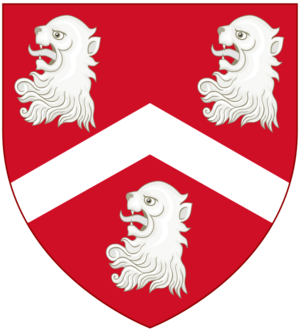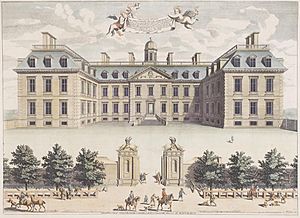Christopher Monck, 2nd Duke of Albemarle facts for kids
Quick facts for kids
The Duke of Albemarle
|
|
|---|---|

Portrait by unknown artist in collection of Trinity College, Cambridge, purchased 1691
|
|
|
Member of Parliament
for Devon |
|
| In office 1667 – 3 January 1670 |
|
| Preceded by | Sir Hugh Pollard, Bt |
| Succeeded by | Sir Coplestone Bampfylde, Bt |
| Member of the House of Lords Hereditary peer |
|
| In office 3 January 1670 – 6 October 1688 |
|
| Personal details | |
| Born | 14 August 1653 |
| Died | 6 October 1688 (aged 35) Jamaica |
| Resting place | 4 July 1689 Westminster Abbey 51°29′58″N 00°07′39″W / 51.49944°N 0.12750°W |
| Nationality | English |
| Spouse |
Lady Elizabeth Cavendish
(m. 1669) |
| Children | 1 |
| Parents |
|
| Education | Gray's Inn |
| Other titles | Earl of Torrington |
Christopher Monck, 2nd Duke of Albemarle (born August 14, 1653 – died October 6, 1688) was an important English politician, military officer, and colonial administrator. He was a member of the House of Commons (a part of the English Parliament) from 1667 to 1670. After his father passed away, he inherited the title of Duke and joined the House of Lords, another part of Parliament.
Contents
Life Story
Early Years
Christopher Monck was the son of George Monck, 1st Duke of Albemarle, a very famous general who helped bring the king back to England in 1660. His mother was Anne Clarges.
Christopher was taught at home. In 1662, he joined Gray's Inn, which was a place where people studied law. Before his father died, Christopher was known by the special title of Earl of Torrington.
His Career
Christopher Monck started his political life at just 13 years old! In January 1667, he was chosen to be a Member of Parliament (MP) for Devon.
In 1670, when his father died, Christopher became the 2nd Duke of Albemarle. This meant he moved from the House of Commons to the House of Lords, where important noble families sat. He also became a Gentleman of the Bedchamber, which was a special role helping the king.
He was given the high honor of being a Knight of the Garter and became a Privy Councillor, advising the king. In 1675, he became the Lord Lieutenant of Devon, a royal representative in the county, serving for ten years. He also became a colonel in several horse regiments of the English Army.
In 1673, he helped create a new army group. This group was meant to fight in the Dutch Republic, but it was stopped before any fighting happened.
The First Boxing Match
Here's a fun fact about Christopher Monck: On January 6, 1681, he organized a boxing match! It was between his butler and his butcher. This is known as the very first recorded boxing match in England. The butcher won!
From 1682 until he passed away, Monck was the Chancellor of the University of Cambridge, a very important role at the famous university.
In 1685, he stepped down from his role as Lord Lieutenant of Devon to help fight against the Monmouth Rebellion, a revolt against the king. However, he wasn't very successful as a military leader in this fight.
Treasure Hunter!
In 1686, Christopher Monck invested a lot of money in a treasure hunt! The expedition was led by William Phips, who found the wreck of a Spanish treasure ship called Nuestra Señora de la Concepción in February 1687. Phips returned to London with a huge amount of treasure, worth over £200,000. Christopher Monck received a big share of this treasure, about 25 percent!
After holding a few more roles, in 1687, Monck was made Lieutenant Governor of Jamaica, a colony in the Caribbean.
Death and What Happened Next
Christopher Monck died in Jamaica on October 6, 1688, when he was 35 years old. He was buried in Westminster Abbey in London. Because he didn't have any children who survived him, all his special titles ended when he died.
His Legacy
Christopher Monck is remembered for a few things:
- He is credited with organizing the first recorded boxing match in England.
- An English explorer named Ambrose Cowley named an island in the Galapagos after him. This island is now known as Isabela Island.
Places He Lived
Potheridge, Devon
His family's main home in Devon was Potheridge. It was a very grand house that his father had rebuilt around 1660. The Monck family had lived there since at least 1287. Most of the house was taken down after his wife, the Duchess, died in 1734. What's left today is the Great Potheridge farmhouse, but you can still see parts of the old mansion inside, like old doorways and a grand staircase.
Clarendon House, London
In 1675, Christopher Monck bought a very fancy London home called Clarendon House for £26,000. He bought it from the family of the person who built it. In 1683, he sold it again to a group of investors. They tore down the house and built new streets on its land, including Albemarle Street, Bond Street, and Dover Street.
His Family
On December 30, 1669, Christopher Monck married Lady Elizabeth Cavendish in London. She was the eldest daughter of Henry Cavendish, 2nd Duke of Newcastle. They had a son who sadly died soon after he was born. Christopher Monck did not have any other children who lived.
In 1692, his wife Elizabeth married again to Ralph Montagu, 1st Duke of Montagu. She was buried in Westminster Abbey in 1734.



